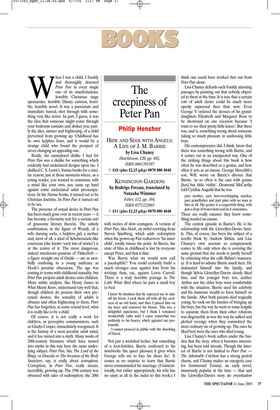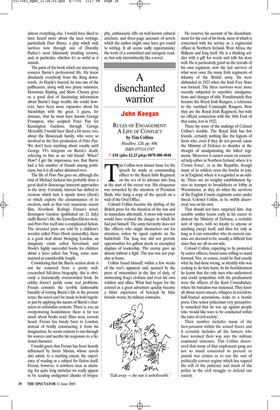The creepiness of Peter Pan
Philip Hensher
HIDE AND SEEK WITH ANGELS: A LIFE OF J. M. BARRIE by Lisa Chaney Hutchinson, £20, pp. 402, ISBN 0091795397 ✆ £18 (plus £2.25 p&p) 0870 800 4848 KENSINGTON GARDENS by Rodrigo Fresan, translated by Natasha Wimmer Faber, £12, pp. 384, ISBN 0571222803 ✆ £11 (plus £2.25 p&p) 0870 800 4848 When I was a child, I frankly and thoroughly detested Peter Pan in every single one of its manifestations; horrible Christmas stage spectacular, horrible Disney cartoon, horrible, horrible novel. It was a passionate and immediate hatred, shot through with something very like terror. In part, I guess, it was the idea that someone might come through your bedroom curtains and abduct you; partly the idea, sinister and frightening, of a child prevented from growing up. Childhood has its own helpless fears, and it would be a strange child who found the prospect of never changing an appealing one.
Really, the unanalysed dislike I had for Peter Pan was a dislike for something which evidently had undeclared designs upon me. I disliked C. S. Lewis’s Narnia books for a similar reason; just at those moments where, as a young reader, you wanted to commune with a mind like your own, you came up hard against some undeclared adult preoccupations. In the Narnia books, it turned out to be Christian doctrine. In Peter Pan it turned out to be sex.
The presence of sexual desire in Peter Pan has been much gone over in recent years — it has become a favourite text for a certain sort of gruesome literary theorist. The unholy combination, in the figure of Wendy, of a wife darning socks, a helpless girl, a mother and, most of all, a kind of Scheherazade-like courtesan (she knows ‘such lots of stories’) is at the centre of it. The more dangerous, indeed murderous passions of Tinkerbell a figure straight out of Ouida — are as morbidly confusing to a young audience as Hook’s peculiar obsessions. The age was coming to terms with childhood sexuality, but Peter Pan projects adult desires onto children. More subtle analysts, like Henry James in What Maisie Knew, understand very well that, though children do possess their own presexual desires, the sexuality of adults is obscure and often frightening to them. Peter Pan has forgotten, at some crucial level, what it is really like to be a child.
Of course, it is not really a work for children, as perceptive commentators, such as Gladys Cooper, immediately recognised. It is the fantasy of a most peculiar adult mind, and it has turned into a myth. Many works of 20th-century literature which have turned into myths in this way have the same underlying subject. Peter Pan, like The Lord of the Rings, or Dracula or The Invasion of the Body Snatchers, say, is really about corruption. Corruption, in Peter Pan, really means, incredibly, growing up. The 19th century was obsessed with tales of redemption; the 20th with stories of slow contagion. A version of Peter Pan, like Hook, an awful rewriting from Steven Spielberg, which adds redemption when the grown-up Pan rediscovers ‘his inner child’, totally misses the point. In Barrie, the state of bliss in childhood is lost by everyone except Peter, and that is that.
Was Barrie what we would now call a paedophile? You could certainly build a much stronger case against him from his writings than, say, against Lewis Carroll. There is a truly horrible passage in The Little White Bird where he puts a small boy to bed:
I knew by intuition that he expected me to take off his boots. I took them off with all the coolness of an old hand, and then I placed him on my knee and removed his blouse. This was a delightful experience, but I think I remained wonderfully calm until I came somewhat too suddenly to his braces, which agitated me profoundly.
I cannot proceed in public with the disrobing of David.
Not just a wretched lecher, but something of a foot-fetishist, Barrie confessed to his notebooks ‘the queer pleasure it gives when George tells me to lace his shoes &c’. It comes as no surprise to learn that Barrie never consummated his marriage. (Unintentionally, but rather appropriately, his wife has no entry at all in the index to this book.) I think one could have worked that out from Peter Pan alone.
Lisa Chaney defends such frankly alarming passages by pointing out that nobody objected to them at the time. It is true that a certain sort of adult desire could be much more openly expressed then than now. Even George V ordered the dresses of his granddaughters Elizabeth and Margaret Rose to be shortened on one occasion because ‘I want to see their pretty little knees’. But there was, and is, something wrong about someone taking so much pleasure in undressing little boys.
His contemporaries did, I think, know that there was something wrong with Barrie, and it comes out in an unexpected way. One of the striking things about this book is how often he was described as a genius, and how often it acts as an excuse. George Meredith’s son, Will, wrote on Barrie’s divorce that Barrie, ‘as so often is the case with genius [has] but little virility’. Desmond McCarthy told Cynthia Asquith that he was
part mother, part hero-worshipping maiden, part grandfather and part pixie with no man in him at all. His genius is a coquettish thing, with just a drop of benevolent acid in it sometimes.
These are really excuses; they knew some thing needed an excuse.
The central episode in Barrie’s life is his relationship with the Llewellyn-Davies family. This, of course, has been the subject of a terrific book by Andrew Birkin, and Lisa Chaney’s own account so conspicuously comes to life only when she is covering the same ground that she needs to justify herself by criticising what she calls Birkin’s inaccuracy. It is hard to admire Barrie much here. He insinuated himself into the family, and though Sylvia Llewellyn-Davies clearly liked him, and the younger boys too, neither Arthur nor the elder boys were comfortable with the situation. Barrie used his celebrity and his immense wealth to force himself on the family. After both parents died tragically young, he took on the burden of bringing up the boys, but the way he went to some lengths to separate them from their other relations was disgraceful, as was the way he sulked and plotted revenge when they committed the most ordinary sin of growing up. The ones he liked best were the ones who died young.
Lisa Chaney’s book suffers under the burden that the story, when it becomes interesting, has been told already. Though the interest of Barrie is not limited to Peter Pan The Admirable Crichton has a strong period charm, and Chaney makes an energetic case for Sentimental Tommy, an early novel, immensely popular at the time — that and the Llewellyn-Davies story do overshadow almost everything else. I would have liked to have heard more about the later writings, particularly Dear Brutus, a play which only survives now through one of Dorothy Parker’s most hilariously insulting reviews, and, in particular, whether it’s as awful as it sounds.
The parts of the book which are interesting concern Barrie’s professional life. He knew absolutely everybody from the King downwards. At Hardy’s funeral, he was one of the pallbearers, along with two prime ministers, Housman, Kipling, and Shaw. Chaney gives us a good deal of fascinating information about Barrie’s huge wealth; she could, however, have been more expansive about his friendships with the great. I guess, for instance, that he must have known George Frampton, who sculpted Peter Pan for Kensington Gardens, through George Meredith; I would have liked a bit more, too, about the Boucicault family, who were so involved in the first production of Peter Pan. We don’t hear anything about royalty until George VI’s telegram on Barrie’s death, referring to him as an ‘old friend’. When? How? I get the impression, too, that Barrie had a fair number of friends among politicians, but it is all rather skimmed over.
The life of Peter Pan goes on, although the trial of Michael Jackson has probably done a great deal to discourage innocent approaches to the story. Certainly, interest has shifted to versions which turn it upside down (Hook) or which explore the circumstances of its creation, such as that very inaccurate recent film, Neverland. Rodrigo Fresan’s novel, Kensington Gardens (published on 21 July) stuffs Barrie’s life, the Llewellyn-Davies story, and Peter Pan itself into a complicated fiction. The invented parts are told by a children’s novelist called Peter Hook (naturally); there is a good deal about Swinging London, an imaginary estate called Neverland, and Hook’s highly successful books for children about a hero called Jim Yang, some summarised at considerable length.
Considering that the Barrie section alone is not far removed from a pretty wellresearched full-dress biography, this is obviously a fantastically overcrowded book. Its oddity doesn’t justify some real problems. Fresan commits the terrible fashionable banality of writing Barrie’s life in the present tense; the novel can’t be made to hold together just by applying the names of Barrie’s characters in unfamiliar contexts. There is, too, an overpowering bookishness; there is far too much about books read, films seen, records heard. Fresan has barely been to London; instead of boldly constructing it from his imagination, he seems content to run through his sources and ascribe his responses to a fictional character.
I would guess that Fresan has been heavily influenced by Javier Marias, whose novels also admit, to a startling extent, the experience of reading as a subject for fiction itself. Fresan, however, is nowhere near as alarming; for quite long stretches we really appear to be reading undigested chunks of biogra phy, enthusiastic riffs on well-known cultural artefacts, and three-page accounts of novels which the author might once have got round to writing. It all seems sadly opportunistic; the work of a committed and energetic reader, but only intermittently like a novel.



















































 Previous page
Previous page